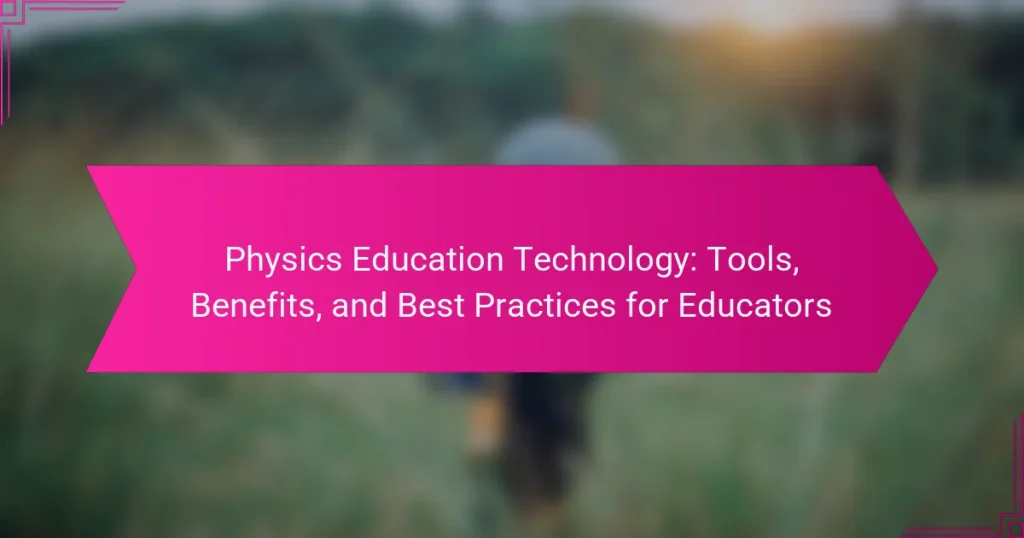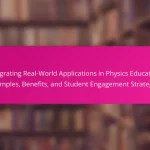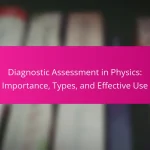Physics Education Technology (PhET) consists of interactive simulations aimed at enhancing the teaching and learning of physics concepts. Developed by the University of Colorado Boulder, PhET simulations cover a range of topics, including mechanics, electricity, magnetism, and waves, and have been shown to improve students’ understanding and engagement in physics. The article explores various tools offered by PhET, such as interactive tutorials and virtual labs, which facilitate hands-on learning experiences. It emphasizes the importance of aligning these technologies with educational objectives, providing professional development for educators, and incorporating student feedback to maximize effectiveness and engagement in physics education. Regular assessment of technology use is also highlighted as essential for optimizing learning outcomes.
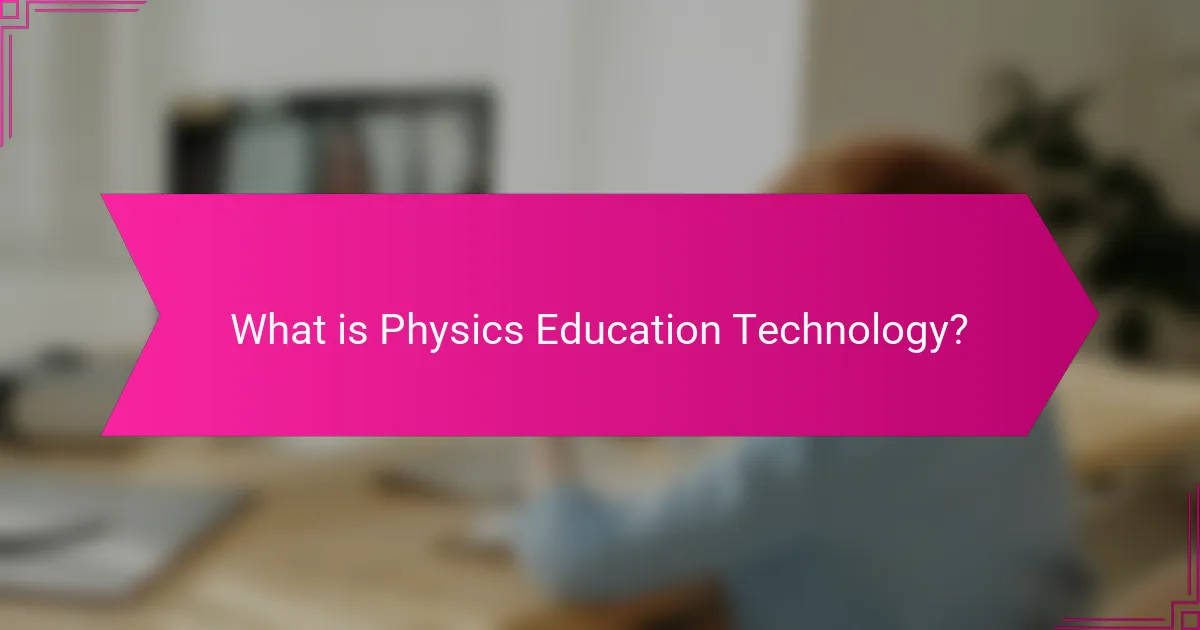
What is Physics Education Technology?
Physics Education Technology (PhET) refers to interactive simulations designed to enhance the teaching and learning of physics concepts. Developed by the University of Colorado Boulder, PhET provides a platform for students to visualize and experiment with physics phenomena. These simulations cover various topics, including mechanics, electricity, magnetism, and waves. Research shows that using PhET simulations can improve students’ understanding and engagement in physics. A study published in the journal “Physical Review Special Topics – Physics Education Research” found that PhET simulations significantly enhance conceptual understanding.
How does Physics Education Technology enhance learning experiences?
Physics Education Technology enhances learning experiences by providing interactive simulations and visualizations. These tools allow students to explore complex concepts in a hands-on manner. For example, simulations can demonstrate principles like motion, force, and energy. This interactivity fosters deeper understanding and retention of material. Furthermore, technology can tailor learning experiences to individual student needs. Research shows that students using educational technology perform better in assessments. According to a study by the National Science Foundation, technology integration in physics education leads to improved engagement and academic performance.
What are the key features of effective Physics Education Technology tools?
Effective Physics Education Technology tools have several key features. They provide interactive simulations that enhance student engagement. These tools offer real-time feedback to help students understand concepts better. They support collaborative learning, allowing students to work together on projects. Effective tools also include a user-friendly interface for ease of use. They are aligned with curriculum standards to ensure relevance. Additionally, they offer data analytics to track student progress. These features contribute to a more effective learning experience in physics education.
How do these features support various learning styles?
Physics Education Technology features support various learning styles by providing interactive and visual learning experiences. Visual learners benefit from simulations and animations that illustrate complex concepts. Kinesthetic learners engage through hands-on experiments and virtual labs that allow experimentation. Auditory learners gain from narrated tutorials and discussions that explain theories clearly. These features cater to diverse preferences, enhancing understanding and retention. Research shows that multimodal learning approaches improve student performance and engagement in physics education.
What are the benefits of using Physics Education Technology in classrooms?
Using Physics Education Technology in classrooms enhances student engagement and understanding of complex concepts. It provides interactive simulations that allow students to visualize and manipulate physical phenomena. This hands-on approach fosters deeper comprehension and retention of material. Additionally, it supports differentiated learning by catering to various learning styles. Research shows that students using such technology perform better on assessments. For instance, a study published in the “Journal of Science Education and Technology” found that students using simulations scored 20% higher on physics tests. Overall, Physics Education Technology effectively bridges the gap between theoretical knowledge and practical application.
How does Physics Education Technology improve student engagement?
Physics Education Technology improves student engagement by providing interactive learning experiences. These technologies include simulations, virtual labs, and multimedia resources. Interactive simulations allow students to visualize complex concepts in real-time. This hands-on approach encourages active participation and exploration. Additionally, virtual labs enable students to conduct experiments without physical limitations. Research indicates that students using such technologies show higher motivation and interest in physics. A study by the American Association of Physics Teachers found that 80% of students reported increased engagement when using technology in lessons. By fostering a more dynamic learning environment, Physics Education Technology enhances overall student involvement.
What impact does Physics Education Technology have on student performance?
Physics Education Technology positively impacts student performance. It enhances understanding of complex concepts through interactive simulations. Students using these technologies demonstrate improved engagement and motivation. Research indicates that technology integration leads to higher test scores and better retention of material. For example, a study by the National Science Foundation found that students using physics simulations scored 20% higher on assessments. Additionally, Physics Education Technology facilitates personalized learning experiences, catering to diverse learning styles. Overall, it supports active learning, which is crucial for mastering physics concepts.
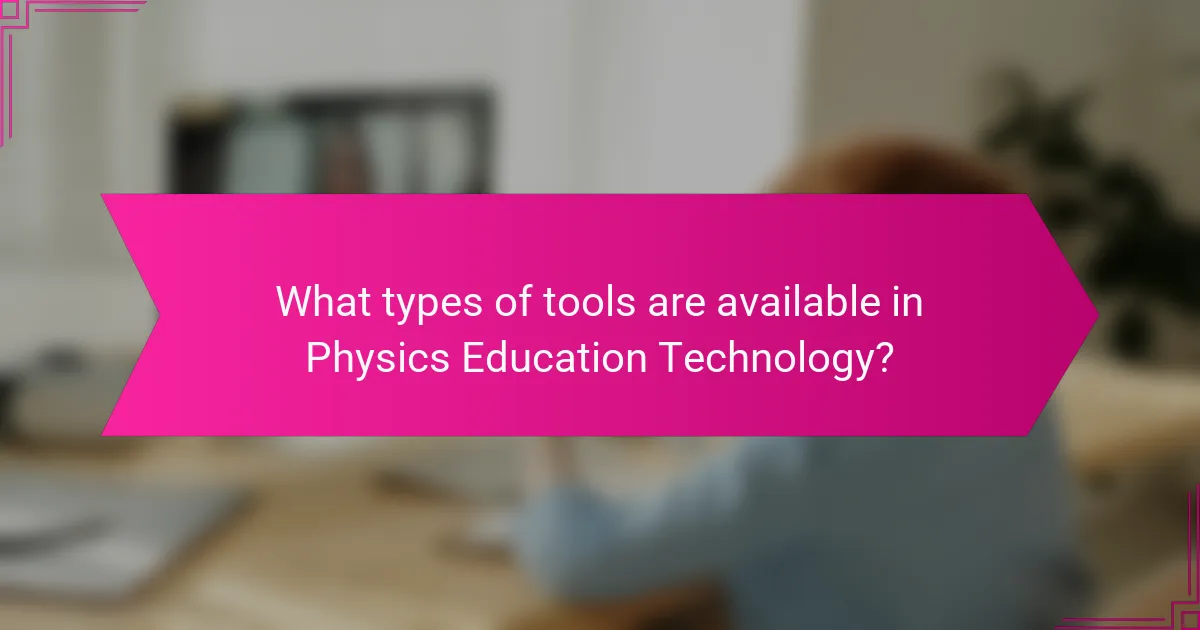
What types of tools are available in Physics Education Technology?
Physics Education Technology offers various tools for teaching and learning physics. These tools include simulations, interactive tutorials, and virtual labs. Simulations allow students to visualize complex concepts. Interactive tutorials facilitate hands-on learning experiences. Virtual labs enable experimentation in a controlled environment. Other tools include data analysis software and assessment platforms. These resources enhance engagement and understanding. They are widely used in educational settings to improve learning outcomes.
What are the most common software tools used in Physics education?
The most common software tools used in Physics education include simulations, data analysis tools, and interactive learning platforms. Popular simulation software includes PhET Interactive Simulations, which allows students to visualize complex physics concepts. Data analysis tools such as Logger Pro and MATLAB help students analyze experimental data effectively. Interactive platforms like Labster provide virtual lab experiences to enhance learning. These tools are widely adopted in educational institutions for their ability to facilitate understanding of physics principles through practical application and engagement.
How do simulation tools facilitate understanding of complex physics concepts?
Simulation tools enhance the understanding of complex physics concepts by providing interactive visualizations. These tools allow students to manipulate variables and observe outcomes in real-time. This interactivity fosters deeper engagement with the material. For instance, simulations can demonstrate abstract concepts like wave behavior or electromagnetism visually. Research shows that students using simulation tools often outperform peers in traditional learning settings. A study by the National Science Foundation found that simulations improve conceptual understanding by 30%. Furthermore, simulations can model scenarios that are difficult or impossible to recreate in a classroom. This accessibility helps bridge gaps in understanding for diverse learners.
What role do interactive platforms play in Physics education?
Interactive platforms enhance Physics education by providing engaging, hands-on learning experiences. These platforms facilitate simulations that allow students to visualize complex concepts. They promote active learning through interactive problem-solving and real-time feedback. Research shows that students using interactive platforms perform better in understanding Physics principles. For instance, a study published in the Journal of Science Education and Technology found that interactive simulations improve conceptual understanding and retention. Such platforms also encourage collaboration among students, fostering a community of inquiry. Overall, interactive platforms play a crucial role in making Physics education more accessible and effective.
What hardware tools are utilized in Physics Education Technology?
Physics Education Technology utilizes various hardware tools. Common tools include computers, data acquisition systems, and sensors. Computers are essential for simulations and data analysis. Data acquisition systems collect real-time data during experiments. Sensors measure physical quantities like temperature, pressure, and motion. Other tools include projectors for visual presentations and interactive whiteboards for collaborative learning. These hardware components enhance the learning experience in physics education. They facilitate hands-on experiments and interactive simulations, promoting better understanding of complex concepts.
How do laboratory equipment and sensors enhance practical learning?
Laboratory equipment and sensors enhance practical learning by providing hands-on experience in scientific experimentation. They allow students to observe real-time data and phenomena, which deepens understanding. For example, sensors can measure temperature, pressure, and pH levels during experiments. This immediate feedback helps students grasp complex concepts more effectively. Studies show that students using laboratory equipment score higher in assessments related to practical skills. The National Science Teachers Association emphasizes the importance of hands-on learning in fostering inquiry and critical thinking. Thus, laboratory equipment and sensors are essential for effective physics education.
What are the advantages of using virtual reality in Physics education?
Virtual reality (VR) enhances Physics education by providing immersive and interactive learning experiences. It allows students to visualize complex physical concepts in a three-dimensional space. This engagement improves understanding and retention of material. Research shows that students using VR demonstrate higher motivation and interest in learning. A study by Mikropoulos and Natsis (2011) found that VR significantly enhances spatial visualization skills. Additionally, VR can simulate experiments that may be dangerous or impractical in a traditional classroom. This capability allows students to conduct experiments safely and repeatedly. Overall, VR in Physics education fosters deeper comprehension and practical application of theoretical concepts.
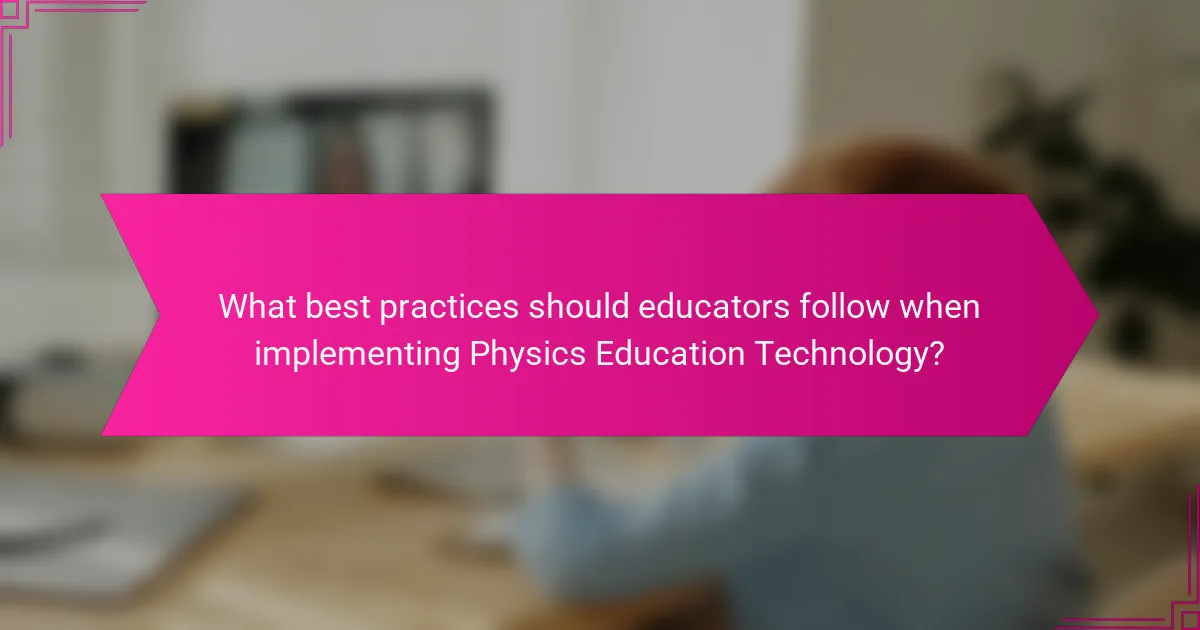
What best practices should educators follow when implementing Physics Education Technology?
Educators should prioritize alignment of Physics Education Technology with learning objectives. This ensures that technology enhances the curriculum effectively. They should also provide professional development for teachers. This training enables educators to utilize technology confidently. Additionally, incorporating student feedback is essential. This practice helps tailor technology use to student needs. Using diverse technology tools can cater to different learning styles. This approach maximizes engagement and understanding. Regular assessment of technology effectiveness is also crucial. This allows for adjustments based on student performance and feedback. Implementing these best practices leads to a more effective educational experience in physics.
How can educators effectively integrate Physics Education Technology into their curriculum?
Educators can effectively integrate Physics Education Technology (PET) into their curriculum by aligning technology tools with learning objectives. They should first assess the specific needs of their students. This includes understanding their learning styles and challenges. Next, educators can select appropriate PET tools that enhance conceptual understanding. Examples include simulations, interactive labs, and virtual experiments.
Training is crucial for educators to use these technologies effectively. Professional development opportunities can equip them with necessary skills. Additionally, incorporating PET into lesson plans can facilitate active learning. This approach encourages student engagement and collaboration.
Regular feedback from students can help refine the use of technology. Educators should adapt their methods based on this feedback. Research indicates that the use of PET can improve student outcomes in physics. A study by the American Association of Physics Teachers found that technology integration leads to higher student achievement.
What strategies can be used to assess the effectiveness of these tools?
To assess the effectiveness of physics education technology tools, educators can implement several strategies. One effective strategy is to conduct pre- and post-assessments. This method measures students’ understanding before and after using the tools. Surveys can also gather student feedback on their learning experiences. Analyzing engagement metrics, such as participation rates, provides insights into how tools impact student interaction. Classroom observations can offer qualitative data on student collaboration and problem-solving skills. Additionally, comparing student performance against control groups using traditional methods can highlight the tools’ effectiveness. Research indicates that these strategies provide a comprehensive evaluation of educational technology impact.
How can collaboration among educators improve the use of Physics Education Technology?
Collaboration among educators can enhance the use of Physics Education Technology by sharing resources and best practices. When educators work together, they can pool their knowledge on effective tools. This leads to more comprehensive training for teachers in technology use. Collaborative efforts can also foster innovation in teaching methods. For instance, joint workshops can introduce new software or equipment to multiple educators simultaneously. Research shows that collaborative teaching environments improve student engagement and learning outcomes. A study by the University of California found that teachers who collaborated reported higher confidence in using educational technology. Therefore, collaboration directly contributes to more effective implementation of Physics Education Technology.
What common challenges do educators face with Physics Education Technology?
Educators face several common challenges with Physics Education Technology. One major issue is the lack of training in using these technologies effectively. Many educators feel unprepared to integrate technology into their teaching. This can lead to ineffective use or avoidance of these tools altogether. Additionally, there is often insufficient access to resources or equipment. Some schools may not have the budget for the latest technology. Another challenge is the variability in student engagement with technology. Not all students respond positively to tech-based learning methods. Furthermore, educators may struggle with aligning technology use to curriculum standards. This misalignment can hinder the educational process. Lastly, there are concerns regarding the reliability of technology. Technical issues can disrupt lessons and frustrate both educators and students.
How can educators troubleshoot technical issues in the classroom?
Educators can troubleshoot technical issues in the classroom by following a systematic approach. First, they should identify the specific problem, such as connectivity issues or software malfunctions. Next, they can check all equipment connections, ensuring everything is properly plugged in and powered on. If the issue persists, restarting devices often resolves many common problems.
Educators should also consult user manuals or online resources for troubleshooting guides specific to their technology. Collaborating with IT support can provide additional expertise for more complex issues. Regular training sessions on technology use can help educators become familiar with potential problems and solutions.
According to a study by the International Society for Technology in Education, 75% of educators reported that proper training improved their ability to handle technical issues effectively. This indicates that ongoing professional development is crucial for successful technology integration in classrooms.
What solutions exist for overcoming resistance to technology adoption in Physics education?
Professional development programs can help overcome resistance to technology adoption in Physics education. These programs provide educators with training on new technologies and their applications in the classroom. Research shows that teachers who receive targeted training are more likely to integrate technology effectively. Additionally, fostering a collaborative environment encourages educators to share experiences and strategies. Providing ongoing technical support can alleviate concerns about using unfamiliar tools. Engaging students in technology-driven learning can also demonstrate its benefits. Finally, aligning technology use with curriculum goals can help educators see its relevance.
What are some practical tips for maximizing the benefits of Physics Education Technology?
Integrating interactive simulations enhances student engagement in Physics Education Technology. Utilize platforms like PhET to provide hands-on experiences. Incorporate real-time data collection tools, such as sensors and data loggers, to facilitate experiments. Use multimedia resources, like videos and animations, to illustrate complex concepts. Encourage collaborative projects that utilize technology for problem-solving. Regularly update and adapt technology tools to align with curriculum changes. Provide training for educators to effectively use these technologies. Research shows that technology integration can improve student understanding and retention of physics concepts.
Physics Education Technology (PhET) encompasses interactive simulations designed to improve the teaching and learning of physics concepts. This article explores the features, benefits, and best practices associated with implementing PhET tools in educational settings. Key topics include how these technologies enhance student engagement, cater to diverse learning styles, and improve academic performance. Additionally, the article addresses common challenges educators face and offers practical tips for maximizing the effectiveness of physics education technology in the classroom.
